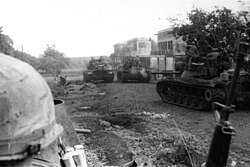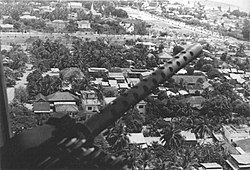Pol Pot
Pol Pot (born Saloth Sâr; May 19, 1925 – April 15, 1998[2]) was a Cambodian National Communist politician who was the dictator of Cambodia from 1975 to 1979.[3][4] He was also the leader of the Khmer Rouge, who were radical members of the country's Communist Party.[5] Pol Pot's government consisted of armed peasants. His government killed between 1.7 and 2.2 million people in the Cambodian genocide. He has been called one of the most brutal dictators in world history.[6]
Pol Pot | |
|---|---|
ប៉ុល ពត | |
 Pol Pot in 1978 | |
| General Secretary of the Communist Party of Kampuchea | |
| In office 22 February 1963 – 6 December 1981 | |
| Deputy | Nuon Chea |
| Preceded by | Tou Samouth (1962) |
| Succeeded by | Position abolished (party dissolved) |
| Leader of Cambodia | |
| De facto 17 April 1975 – 7 January 1979 | |
| President | Norodom Sihanouk Khieu Samphan |
| Prime Minister | Penn Nouth Himself |
| Preceded by | Sak Sutsakhan |
| Succeeded by | Pen Sovan[a] Heng Samrin[b] |
| Prime Minister of Democratic Kampuchea | |
| In office 25 October 1976 – 7 January 1979 | |
| President | Khieu Samphan |
| Deputy | |
| Preceded by | Khieu Samphan (acting) |
| Succeeded by | Nuon Chea (1981) |
| In office 14 April 1976 – 27 September 1976 | |
| President | Khieu Samphan |
| Deputy | |
| Preceded by | Khieu Samphan (acting) |
| Succeeded by | Nuon Chea (acting) |
| Commander-in-chief of Kampuchea Revolutionary Army | |
| In office 1977–1979 | |
| General Secretary of the Party of Democratic Kampuchea | |
| In office 1981–1985 | |
| Preceded by | Himself (as General Secretary of the Communist Party of Kampuchea) |
| Succeeded by | Khieu Samphan |
| Personal details | |
| Born | Saloth Sâr 25 May 1925 Prek Sbauv, Kampong Thom Province, Cambodia, French Indochina |
| Died | 15 April 1998 (aged 72) Choam, Trapeang Prei, Anlong Veng, Oddar Meanchey, Cambodia 14°21′14″N 104°07′17″E / 14.353862°N 104.121282°E |
| Resting place | Choam, Trapeang Prei, Anlong Veng, Oddar Meanchey, Cambodia 14°20′34″N 104°03′29″E / 14.342910°N 104.057948°E |
| Political party |
|
| Other political affiliations | French Communist Party (1950s) |
| Spouse(s) | |
| Children | Sar Patchata[1] |
| Education | EFREI (no degree) |
| Signature | |
| Military service | |
| Allegiance | |
| Branch/service | Kampuchea Revolutionary Army |
| Years of service | 1963–1997 |
| Rank | General |
| Battles/wars | |
Pol Pot was thrown out of power in January 1979, when the North Vietnamese military liberated Kampuchea. However, he remained active in politics and in the Khmer Rouge. In 1997, Pol Pot was put under house arrest and died the following year.[7]
Early life
Pol Pot was born on May 19, 1925. His village was around 2 miles (3.2 km) from the capital city of the Kompong Thom province. At that time, Cambodia was a colony of France (part of French Indochina).
Pol Pot's father was a landowner named Pen Saloth.[2] His mother was named Sok Nem, and the family had nine children. Around age 5 or 6, Pol Pot was sent to live with an older brother in Phnom Penh, where he received an education.[2]
Pol Pot's family had connections with the Cambodian royal family. His brother, Loth Suong, was a palace clerk. His cousin was married to Prince Sisowat Monivong and had a son named Kossarak. These connections helped Pol Pot get a scholarship to France.
In 1949, he went to Paris, France, and studied radio electronics. However, he got distracted by Marxism, a form of communism. He didn't study, and his scholarship was taken away. In 1953, he went back to Cambodia and became a communist. The following year, Cambodia gained its independence from France and became the Kingdom of Cambodia.
Revolution
In 1962, Pol Pot became the leader of the Communist Party in Cambodia. This party was illegal and hidden, because Prince Sihanouk did not like Pol Pot nor the Communists.
Pol Pot went to the jungle and created a guerrilla force called the Khmer Rouge. (The Khmer are the main ethnic group in Cambodia, and rouge is French for "red", the colour of communism). As guerilla fighters, they hid and ambushed people rather than being visible and directly attacking their enemies. They were the source of Pol Pot's power. Most Khmer Rouge members were teenagers.
In 1970, the U.S. got rid of Prince Sihanouk and unknowingly made Pol Pot more popular. They also made Prince Sihanouk angry, so he joined Pol Pot, but that alliance only gave Pol Pot an advantage. This created a lot of confusion and only made Pol Pot even more popular.
During the Vietnam War, the United States tried to defeat the communist North Vietnamese, but only drove them deeper into the countryside. Some hid in Cambodia. Between 1969-1973 the U.S. bombed these Cambodian hiding places. Many peasants fled to cities to escape.
Government
On April 17, 1975, Pol Pot entered Phnom Penh, Cambodia's capital city, and took control. He planned for a "super great leap forward", inspired by Mao Zedong's Great Leap Forward in China. But Pol Pot also had portraits of himself just like Adolf Hitler,Benito Mussolini,Hideki Tōjō,Vladimir Lenin,Joseph Stalin,Mao Zedong as well as Enver Hoxha,Walter Ulbricht,Erich Honecker,Nicolae Ceaușescu,and Kim Il Sung and Kim Jong-il,including the infamous Francisco Macías Nguema . Though mainly Lenin,Stalin and Mao
Pol Pot and the Khmer Rouge forced all of the people in Cambodia's cities towards fields in the countryside. Many people died on the way to the fields. The people who survived had to do forced labor from dawn until dusk. Even more died in the fields from hunger, thirst, overwork, and sickness. They were harvesting fruits and rice, but got only a 180-gram can of rice every day. Every tenth day was a rest day, and there were festival days.
The Khmer Rouge government closed banks, made money illegal, and closed free markets. They also made religion illegal. Teenagers had to join the army, and children learned how to set land mines and make booby traps.
People were not allowed to gather in groups. Only two people were allowed to see each other at a time. People were forced to marry in big groups, and they could not choose who they married.

After the Vietnamese and underground Cambodian parties got Pol Pot out of power on January 7, 1979, he went to a zone near Thailand called Pailin. There, he tried to get control of Cambodia again by fighting a ten-year-long guerilla war. The war was not successful, and the Khmer Rouge broke up in the early 1990s.
Scale of the genocide
Pol Pot was responsible for the Cambodian genocide.[8][9] This was the planned, organized persecution and genocide of Cambodians that the Khmer Rouge regarded as enemies. The genocide, malnutrition, and poor medical care killed between 1.5 and 2 million people (around one in every four people in Cambodia). Pol Pot's second in command, Noun Chea (also called Brother Number Two) later said that these mass killings were a mistake.
Death
On the evening of April 15, 1998, Pol Pot died of a possible heart attack in his hut in the jungle. This was just just 2 days before the anniversary of Khmer Rouge's takeover of Cambodia.
Nate Thayer believed that Pol Pot killed himself with diazepam (Valium) and chloroquine to avoid trial.[10][11] He was cremated without any ceremony.[12]
Pol Pot Media
Prek Sbauv, the village where Pol Pot was born and spent his early years
In Paris, Pol Pot was inspired by the writings of Mao Zedong and Joseph Stalin (pictured together in 1949) on how to conduct a revolution
King Sihanouk disbanded the Cambodian government and National Assembly before securing independence from French colonial rule in 1953.
The flag of the Communist Party of Kampuchea, a group whose members were informally known as the "Khmer Rouge"
Notes
- ↑ as General Secretary of the Kampuchean People's Revolutionary Party
- ↑ Head of State of the People's Republic of Kampuchea
References
- ↑ "Pol Pot's daughter weds". The Phnom Penh Post. 17 March 2014. Archived from the original on 10 August 2014. Retrieved 29 June 2014.
- ↑ 2.0 2.1 2.2 "Pol Pot". Encyclopedia Britannica. Retrieved 2024-10-25.
- ↑ "BBC – History – Historic Figures: Pol Pot (1925–1998)". BBC. Archived from the original on 26 October 2019. Retrieved 25 January 2011.
- ↑ Chandler, David (23 August 1999). "Pol Pot". Time Magazine. Archived from the original on February 3, 2011. https://web.archive.org/web/20110203010225/http://www.time.com/time/asia/asia/magazine/1999/990823/pol_pot1.html. Retrieved 4 February 2011.
- ↑ "Khmer Rouge". Encyclopedia Britannica. Retrieved 2024-10-25.
- ↑ "List of Top 10 Most Brutal Dictators in Modern History - History Lists". historylists.org. Archived from the original on 2022-08-09. Retrieved 2023-03-09.
- ↑ "Khmer Rouge: Cambodia's years of brutality" (in en-GB). BBC News. 2010-07-19. https://www.bbc.com/news/world-asia-pacific-10684399. Retrieved 2025-01-06.
- ↑ Kiernan, Ben 2003. The demography of genocide in Southeast Asia: the death tolls in Cambodia, 1975–79, and East Timor, 1975–80. Critical Asian Studies. 35 (4): 585–97.
- ↑ Heuveline, Patrick 2001. The Demographic Analysis of Mortality Crises: The Case of Cambodia, 1970–1979. Forced Migration and Mortality. National Academies Press. p. 124. ISBN 978-0-309-07334-9.
- ↑ "Pol Pot is the Dead One Lying Down: Nate Thayer is the Live One Standing". Nate Thayer. Archived from the original on 2021-08-02. Retrieved 2021-08-02.
- ↑ "Pol Pot 'suicide' to avoid US trial". The Independent. 22 October 2011. Archived from the original on 1 May 2019. Retrieved 31 August 2017.
- ↑ "The Dispatch - Google News Archive Search". news.google.com. Archived from the original on 2021-07-13. Retrieved 2021-07-14.









